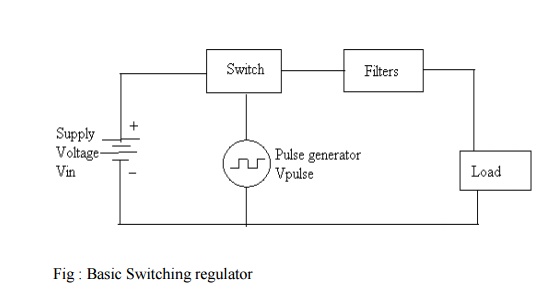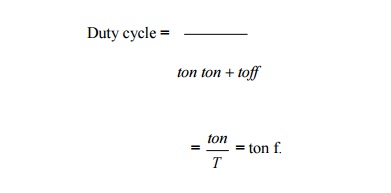Chapter: Linear Integrated Ciruits : Application of ICs
Switching Regulator
SWITCHING REGULATOR:
An
example of general purpose regulator is Motorola‘s MC1723. It can be used in
many different ways, for example, as a fixed positive or negative output
voltage regulator, variable regulator or switching regulator because of its
flexibility.
To
minimize the power dissipation during switching, the external transistor used
must be a switching power transistor.
To
improve the efficiency of a regulator, the series pass transistor is used as a
switch rather than as a variable resistor as in the linear mode.
·
A regulator constructed to operate in this manner
is called a series switching regulator. In such regulators the series pass
transistor is switched between cut off & saturation at a high frequency
which produces a pulse width modulated (PWM) square wave output.
·
This output is filtered through a low pass LC
filter to produce an average dc output voltage.
·
Thus the output voltage is proportional to the
pulse width and frequency.
· The
efficiency of a series switching regulator is independent of the input & output
differential & can approach 95%

A basic
switching regulator consists of 4 major components,
1.
Voltage source Vin
2.
Switch S1
3.
Pulse generator Vpulse
4.
Filter F1
1.
Voltage
Source Vin:
It may be
any dc supply – a battery or an unregulated or a regulated voltage. The voltage
source must satisfy the following requirements.
It must
supply the required output power & the losses associated with the switching
regulator
·
It must be large enough to supply sufficient
dynamic range for line & load regulations.
·
It must be sufficiently high to meet the minimum
requirement of the regulator system to be designed.
·
It may be required to store energy for a specified
amount of time during power failures.
2.
Switch
S1:
It is
typically a transistor or thyristor connected as a power switch & is
operated in the saturated mode. The pulse generator output alternately turns
the switch ON & OFF
3. Pulse generator Vpulse:
It
provides an asymmetrical square wave varying in either frequency or pulse width
called frequency modulation or pulse width modulation respectively. The most
effective frequency range for the pulse generator for optimum efficiency 20
KHz. This frequency is inaudible to the human ear & also well within the
switching speeds of most inexpensive transistors & diodes.
·
The duty cucly of the pulse wave form determines
the relationship between the input & output voltages. The duty cycle is the
ratio of the on time ton, to the period T of the pulse waveform

Where ton = On-time of the pulse waveform
toff=off-time
of the pulse wave form
T = time
period = ton + toff
=
1/frequency
or
T = 1/f
·
Typical operating frequencies of switching
regulator range from 10 to 50khz.
·
Lower operating frequency improve efficiency &
reduce electrical noise, but require large filter components (inductors &
capacitors).
4.
Filter
F1:
It
converts the pulse waveform from the output of the switch into a dc voltage.
Since this switching mechanism allows a conversion similar to transformers, the
switching regulator is often referred to as a dc transformer.
The
output voltage Vo of the switching regulator is a function of duty cycle &
the input voltage Vin.
Vo
is expressed as follows,

·
This equation indicates that, if time period T is
constant, Vo is directly proportional to the ON-time, ton for a given value of
Vin. This method of changing the output voltage by varying ton is referred to
as a pulse width modulation.
·
Similarly, if ton is held constant, the output
voltage Vo is inversely proportional to the period T or directly proportional
to the frequency of the pulse waveform. This method of varying the output
voltage is referred to as frequency modulation (FM).
·
Switching regulator can operate in any of 3 modes
i)
Step – Down
ii) Step – Up
iii) Polarity inverting
Related Topics